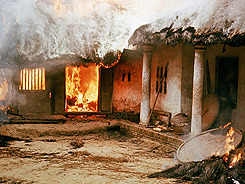






November 12, 1969: An American journalist breaks the story of the My Lai Massacre.
When it took place in March of 1968, the My Lai massacre, which resulted in the death of at least 400 civilians, went unnoticed by the American public. On March 16, American soldiers entered the village of Son My (which contained the My Lai and My Khe hamlets) expecting to engage Viet Cong fighters directly there; in fact, the company’s commanding officer was quoted as telling his men: “They’re all V.C., now go and get them”. The inexperienced soldiers found no evidence of any enemy fighters in the village. Instead of moving on, they began rounding up (unarmed) civilians and shooting them, indiscriminately, brutally - quickly. By the end of the day, the soldiers had finished off (and in some cases tortured or raped) between 347 and 504 civilians. Only one American was injured.
The Americans who attempted to stop the atrocities - Hugh Thompson, Jr. and his helicopter crew - were denounced by some government officials as traitors; when the My Lai Massacre was revealed to the public, the three men received hate mail and death threats, although all three later received the Soldier’s Medal for their actions, which included saving several villagers.
Conversely, the conviction and sentence of 2nd Lt. William Calley, who reportedly personally took it upon himself to mow down civilians with a machine gun, was received with anger by the American public. Flags across the country were flown at half-mast in his honor, and more than one state legislature requested clemency on his behalf. Still, when Seymour Hersh broke the story of the massacre on November 12, 1968 in a report for which he received a Pulitzer Prize, American anti-war sentiment reached new heights, and outrage over the massacre and subsequent cover-up was not only domestic but international as well. In 1970, the United States Army charged over a dozen officers in connection with the massacre, but in the end, only William Calley was convicted - even Calley’s sentence was reduced from life in prison to three years under house arrest. Senior army officials reasoned that Calley had believed that he had simply been “following orders”…
Most photographs of the event were taken by Ronald Haeberle; some of them can be viewed here.